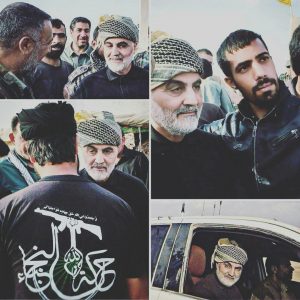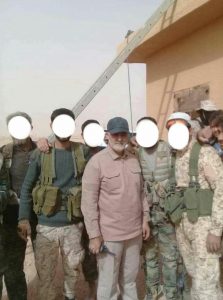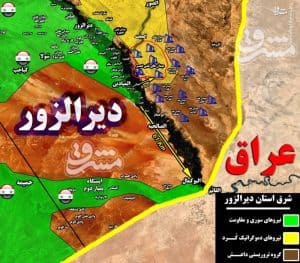
Iraqi Harakat Hezbollah al Nujaba has posted photos of Major General Qassem Soleimani, Islamic Revolutionary Guard Corps (IRGC) Qods Force chief, inspecting positions near Al Bukamal in Syria near the Iraqi border. The town sits on a major border crossing into Iraq. The photo was taken on Tuesday, according to the group. His presence underscores the importance of the offensive in eastern Syria.
While Harakat Hezbollah al Nujaba is nominally a member of the Iraqi Popular Mobilization Forces (PMF), and thus technically an Iraqi government force, the relationship between it and Soleimani is that of a commander and its subordinate.
Earlier this month, a photo of Soleimani allegedly near T-2 pumping station, an area in southern Deir Ezzor province that has served as launching pad for offensive toward Al Bukamal, circulated on social media, but that is unconfirmed.

Iran, Russia and Syria are spearheading operations to gain territory in eastern Syria and wrestle the border town from the Islamic State. Backed by Russian air-power, Iranian-led Shiite jihadists including Lebanese Hezbollah, Afghan Fatemiyoun Division and Iraqi militias and allies are the main boots on the ground. Earlier in the summer, Iran challenged the US presence in Tanf, southeastern Syria, with its militias and drones. These tests were met with force. Iranian-led forces eventually circled around the US base and advanced alongside the Iraqi border toward Deir Ezzor province.
Meanwhile, to the north, by the banks of the Euphrates River, pro-regime forces broke the siege of Deir Ezzor city and then captured al Mayadin last month [see FDD’s Long War Journal report, Russia and Iran help capture Syria’s al Mayadin from Islamic State].

Map 1: Map posted by IRGC-affiliated media outlet Mashregh News, November 8.
Last week, pro-regime forces advancing in southern Deir Ezzor province reached the outskirts of Al Bukamal. Initially encountering little resistance, they declared victory last Thursday, even hailing the end of the Islamic State in Syria – unaware that the Sunni jihadists had laid a trap.
“Islamic State militants began surprise attacks with suicide bombers and rocket attacks after the Iranian militias were duped that Daesh (Islamic State) had left the city,” a tribal leader told Reuters.
Forced to retreat to positions outside the town, the Iranian-led militants and allies are fighting for control of the town. Russia continues its intense bombing campaign. US-led coalition forces have also bombed Islamic State positions in the area, as well as near the adjacent town of Qaim in Iraq, which was taken by Iraqi forces and allies earlier this month. Iranian-backed militias have contributed to campaigns on both sides of the border, but they are more instrumental in Syria.
Securing the Bukamal-Qaim border crossing would open a viable land route between Iran and Syria that has been lost to these allies since insurgents shut down most major border crossings in 2012. After the fall of Bukamal-Qaim border crossing in that year, The New York Times citing senior American officials reported that Iran resumed flying over Iraqi airspace to supply Assad, as highlighted in Iranian Strategy in Syria report by the American Enterprise Institute.
This week, the IRGC’s official daily newspaper Javan published on op-ed on the significance of taking the border crossing. “The liberation of Al Bukamal means the completion of last ring of the resistance’s land corridor, based on which Tehran would have land access to Mediterranean sea and Beirut, which is rare in Iran’s several-millennia-long history.” The author, however, conceded that US-backed Syrian Democratic Forces’ (SDF) seizure of the Omar oil field, Syria’s largest and most important oil facility, gives control of “one of Syria’s most important economic arteries to Syria” that is essential to “reconstruction.” The op-ed accuses the US of cutting a deal with the Islamic State to evacuate 4,000 militants out of Raqqa in order to undermine pro-Damascus forces and to take the Omar field, citing a recent BBC report that actually detailed a secret deal to evacuate jihadists only in exchange for ending the fight in the city. The report did not mention negotiations over control of the Omar oil field, which the SDF could have – and did – take by force late last month. Nevertheless, Javan predicted the US could use the oil well as a bargaining chip in future negotiations “in the most optimistic scenario” and “cripple Syria” and split the country in the “worse scenario.”
Javan concluded the US faces two choices in Syria: leave or define a new mission. It analyzes that American policymakers have yet to reach a final decision, and issued a threat: “if the Americans decide to continue their military presence in Syria, it means the war of the resistance would enter a new phase, the final goal of which is to force the Americans to leave northeastern Syria.”
Earlier this month, Syrian president Bashar al Assad suggested he might take the fight to SDF and toward Raqqa after the end of the Deir Ezzor operation, a message echoed by the Iranian Supreme Leader’s senior foreign policy adviser, Ali Akbar Velayati.
It remains to be seen whether these postures would translate to a fight on the ground. While threats to directly attack American troops should be taken with a grain of salt, the pro-regime alliance has previously struck US-backed forces. Soleimani has overseen attacks against US forces during the Second Gulf War (2003 – 2011) and has supported the Taliban insurgency against the US. The pro-regime alliance is concerned about US influence over major Syrian oil fields and wants to drive the US out of the country. The US administration’s Syria policy has thus far been inconsistent with its proclaimed broader policy of pushing back against the Islamic Republic, and has not indicated commitment to Syria beyond the defeat of the Islamic State. There is nonetheless a risk of clashes between these powers.








4 Comments
Abadi’s Islamic Dawa Party has been in Iran’s pocket for years. The only member of the National Iraq Alliance which I’m not certain about in that regard is the Islamic Virtue Party, but the rest of the NIA is Iran’s — bought, paid for, housebroken and wearing chastity belts.
McGurk & Tillerson keep yammering about the “Baghdad” government. They speak of the Iraqi Armed Forces and the Hashd al-Shaabi as if the two are day-and-night. Neither man has a brain, nor a spine.
find-kill
Since Major General Qassem Soleimani has been responsible for the murder of Americans, if we find him in the Syrian conflict zone, why would he not be fair game for a drone strike?
I think it’s quite pragmatic of the Trump administration to concentrate on the military defeat of ISIS over regime change. Personally I dont really care if the Shia in Lebanon, Syria, Iraq and Iran find cooperation for the same purpose expedient. What I do care about is a Wahabbi Salafist pseudo-caliphate staging terrorist operations against western countries, and causing a hemorrhage of unwelcome migrants towards the same. The west can’t start a war with Russia ( guarantor of the anti-ISIS Shia) simply because it ‘might’ at some point in the future, have a conflict or interest, or actual conflict, with Israel. Pragmatism and Realpolitik should be the first options.